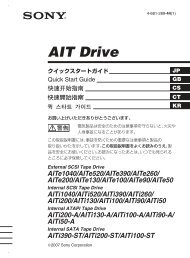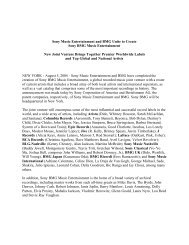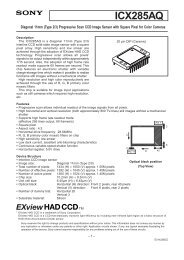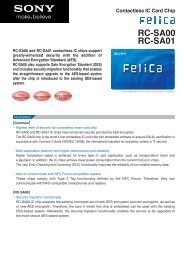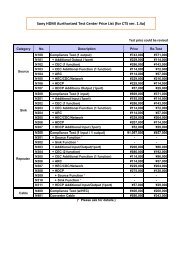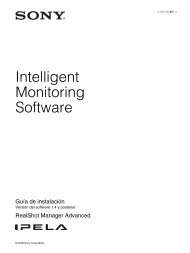PDF [4833KB] - Sony
PDF [4833KB] - Sony
PDF [4833KB] - Sony
You also want an ePaper? Increase the reach of your titles
YUMPU automatically turns print PDFs into web optimized ePapers that Google loves.
LIQUIDITY AND CAPITAL RESOURCES<br />
<strong>Sony</strong>’s financial policy is to secure adequate<br />
liquidity and financing for its operations and to<br />
maintain the strength of its balance sheet.<br />
<strong>Sony</strong>’s mid-term fund requirements are expected<br />
to increase due to restructuring charges<br />
and investments in research, development and<br />
capital expenditures for key devices, including<br />
next generation broadband microprocessors.<br />
These increases in expenses and investments<br />
are part of the fundamental reform plan,<br />
Transformation 60, which is being undertaken<br />
across the entire <strong>Sony</strong> Group and was started<br />
in the fiscal year beginning April 1, 2003 (refer<br />
to “Issues Facing <strong>Sony</strong> and Management’s<br />
Responses to those Issues” and “Forecast of<br />
Consolidated Results” below).<br />
In regards to the funding requirements that<br />
arise from this business strategy, working<br />
capital needs, repayment of existing debt, and<br />
all its other capital needs, <strong>Sony</strong> believes that it<br />
can maintain sufficient liquidity and financial<br />
flexibility through operating cash flow and<br />
cash and cash equivalents, its ability to procure<br />
necessary funds from the financial and capital<br />
markets, its commitment lines with banks, and<br />
other means.<br />
Depreciation and amortization<br />
(Billion ¥)<br />
400<br />
300<br />
200<br />
100<br />
0<br />
02 03 04<br />
*Year ended March 31<br />
* Including amortization expenses for intangible assets<br />
and for deferred insurance acquisition costs<br />
Capital expenditures (additions to property, plant<br />
and equipment)<br />
(Billion ¥)<br />
500<br />
400<br />
300<br />
200<br />
100<br />
0<br />
02 03 04<br />
*Year ended March 31<br />
CAPITAL RESOURCES<br />
<strong>Sony</strong> Corporation, SGTS, a <strong>Sony</strong> finance<br />
subsidiary in the U.K., and <strong>Sony</strong> Capital<br />
Corporation (“SCC”), a <strong>Sony</strong> finance subsidiary<br />
in the U.S., procure funds from the financial<br />
and capital markets.<br />
In order to meet long-term funding requirements,<br />
<strong>Sony</strong> Corporation utilizes its access to<br />
global equity and bond markets. In December<br />
2003, <strong>Sony</strong> Corporation issued 250 billion yen<br />
in euro yen zero coupon convertible bonds,<br />
due in 2008. The purpose of the issuance was<br />
to acquire funds for the growth strategy component<br />
of Transformation 60. <strong>Sony</strong> has a shelf<br />
registration of 200 billion yen in the Japanese<br />
domestic bond market, of which there was no<br />
outstanding balance as of March 31, 2004.<br />
In order to meet the working capital requirements<br />
of the Group, <strong>Sony</strong> maintains commercial<br />
paper (“CP”) programs and medium-term<br />
note (“MTN”) programs through SGTS and<br />
SCC. SGTS maintains a CP program for both<br />
the U.S. and Euro CP markets, and a CP program<br />
in the Japanese CP market. SCC maintains<br />
a CP program in the U.S. market. As of<br />
March 31, 2004, the total amount of these CP<br />
programs was 1,873.4 billion yen. During the<br />
fiscal year ended March 31, 2004, the largest<br />
month-end outstanding balance of CP at <strong>Sony</strong><br />
was 200.1 billion yen in November 2003.<br />
There was no outstanding balance of CP as of<br />
March 31, 2004.<br />
Regarding MTNs, SGTS maintains a Euro<br />
MTN program, while SCC maintains a Rule<br />
144A U.S. MTN program. The total amount of<br />
these MTN programs as of March 31, 2004<br />
was 845.2 billion yen, and the total outstanding<br />
balance was approximately 60.5 billion<br />
yen. SCC maintains another Euro MTN program<br />
apart from these MTN programs shown<br />
above, but <strong>Sony</strong> does not intend to utilize this<br />
program for future financing requirements as<br />
<strong>Sony</strong> intends to concentrate its Euro MTN programs<br />
at SGTS.<br />
LIQUIDITY MANAGEMENT AND<br />
COMMITMENT LINES<br />
<strong>Sony</strong> defines its liquidity sources as (a) cash,<br />
cash equivalents and time deposits, and (b)<br />
committed lines of credit contracted with<br />
financial institutions rated “C” or above in<br />
Bank Financial Strength ratings from Moody’s.<br />
<strong>Sony</strong>’s basic policy is to maintain liquidity equal<br />
to at least 100 percent of the sum of a) the<br />
amount of average monthly sales and b) the<br />
amount of the largest expected monthly debt<br />
redemption during the fiscal year. Although its<br />
working capital needs have a general tendency<br />
to grow in the third quarter (from October to<br />
December), <strong>Sony</strong> believes that this policy is<br />
sufficient to meet its working capital requirements<br />
for any given fiscal year.<br />
On March 31, 2004, the amount of liquidity<br />
sources, as defined by <strong>Sony</strong>, held by consolidated<br />
<strong>Sony</strong> excluding <strong>Sony</strong> Life., <strong>Sony</strong> Assurance,<br />
and <strong>Sony</strong> Bank was 1,118.0 billion yen.<br />
Of this total, cash, cash equivalents and time<br />
deposits were 601.1 billion yen and contracts<br />
for commitment lines with banks rated “C” or<br />
above totaled approximately 516.9 billion yen,<br />
of which the unused amount was approximately<br />
515.6 billion yen. <strong>Sony</strong> also has additional<br />
commitment lines supporting its<br />
operational needs with some financial institutions,<br />
which have Moody’s financial strength<br />
ratings of “C” or below, and these lines<br />
amount to approximately 302.8 billion yen.<br />
Refer to Note 11 of the Consolidated Financial<br />
Statements for the total amount of commitment<br />
lines regardless of Moody’s financial<br />
strength rating for the fiscal year ended March<br />
31, 2004.<br />
In general, there are no restrictions on how<br />
<strong>Sony</strong>’s borrowings can be used except that<br />
some borrowings may not be used to acquire<br />
securities listed on a U.S. exchange or traded<br />
over-the-counter in U.S., and use of such borrowing<br />
must comply with the rules and regulations<br />
issued by authorities such as the Board of<br />
Governors of the Federal Reserve Board.<br />
79


![PDF [4833KB] - Sony](https://img.yumpu.com/26420643/81/500x640/pdf-4833kb-sony.jpg)

